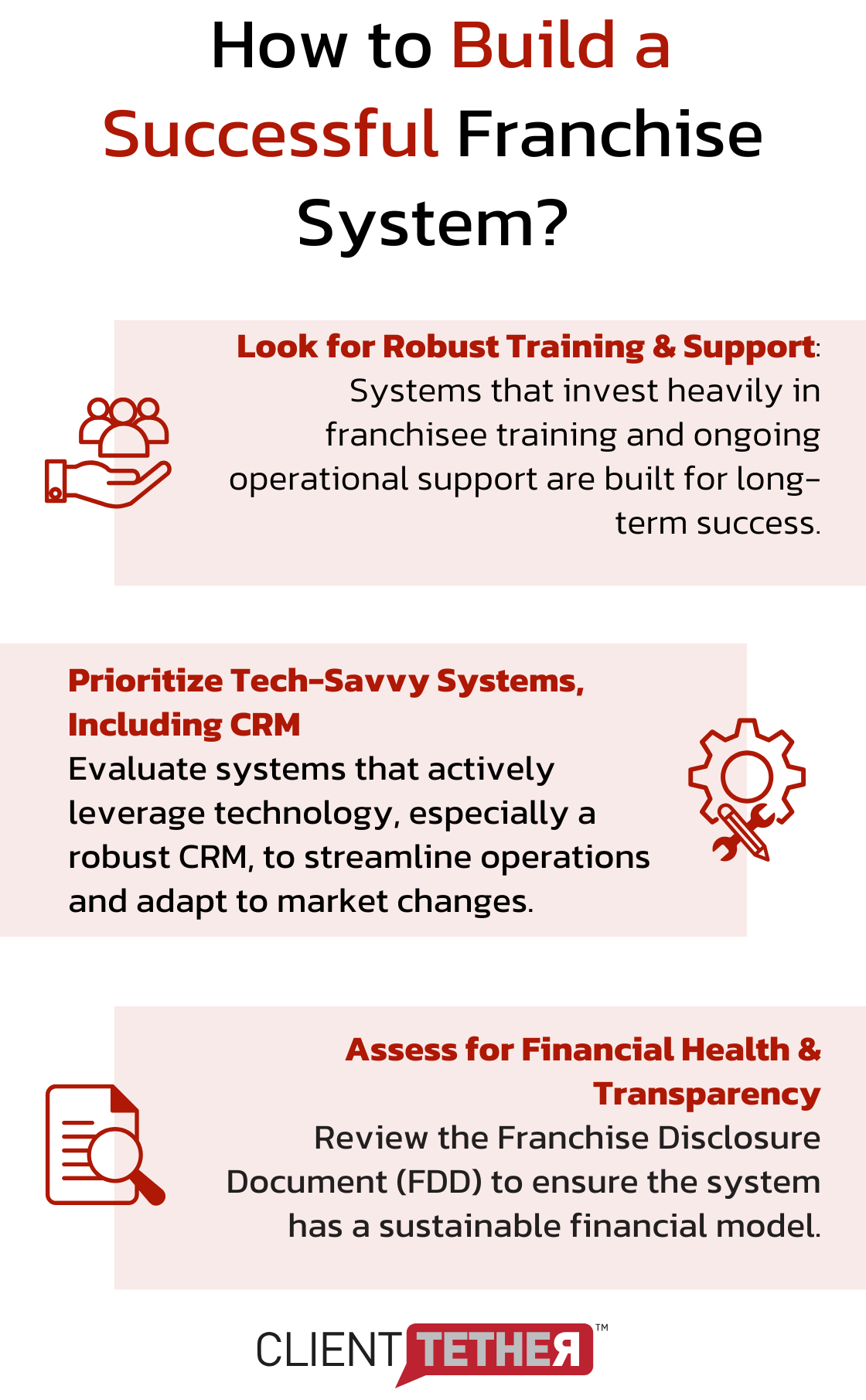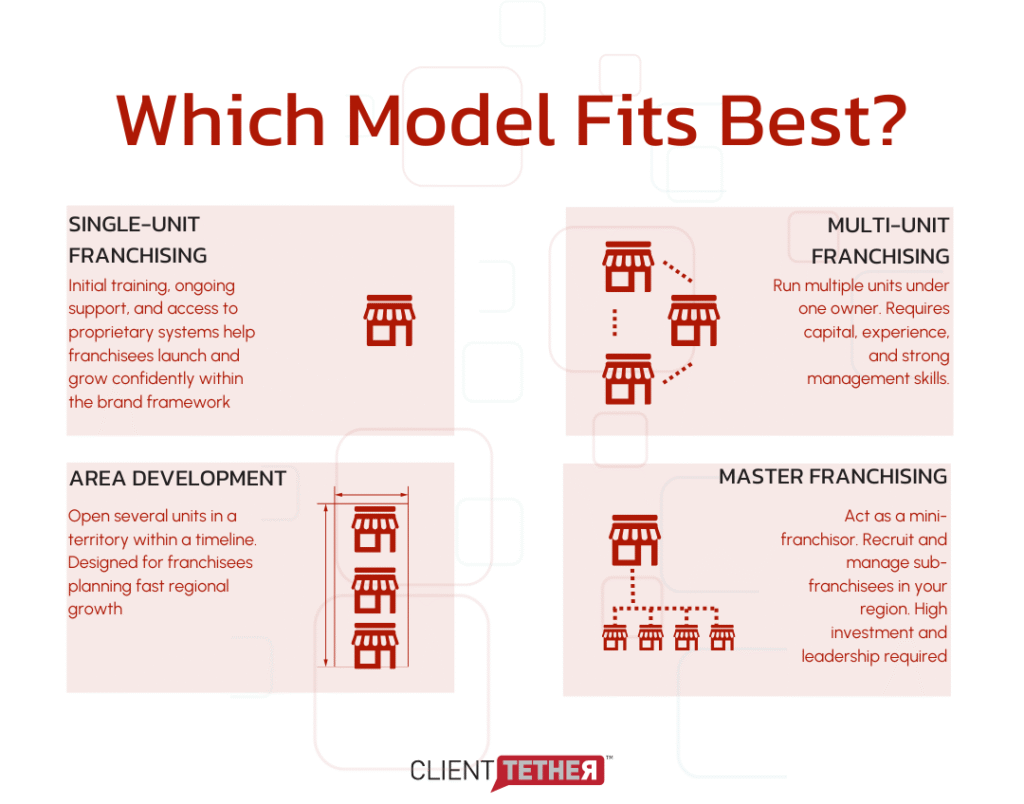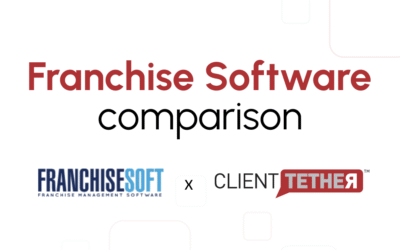Choosing the right franchise system is not as simple as checking a box.
With so many models out there, it’s easy to feel like you’re guessing your way through. But once you know how each one works (and what it demands), things get a whole lot clearer.
We’ve worked with enough franchise brands to know this for sure: the right setup unlocks serious momentum, while the wrong one can stall your growth before it even begins.
This guide breaks down the core franchise systems you need to know, clears the fog on what makes them different, and gives you a clearer path to pick the model that matches your vision.
Traditional Franchise Systems: Proven Pathways to Business Success
Traditional franchise systems are the OGs of the industry: time-tested, proven, and still powering thousands of businesses today.
Whether you’re launching your first brand or scaling your twentieth, it pays to know the four core models that have shaped franchising as we know it. Let’s break them down.
Single-Unit Franchising: The Foundation of Franchise Ownership
Single-unit franchising represents the most common entry point for new franchisees.
In this franchise system, a franchisee operates one location under the franchisor’s brand. It’s an excellent option for first-time business owners or those who want to test the waters of franchising.
This model allows franchisees to concentrate all their energy on one location, mastering the business operations before considering expansion.
Multi-Unit Franchising: Scaling Your Business Empire
Multi-unit franchising involves owning and operating multiple franchise units.
This model attracts experienced franchisees looking to expand their business portfolio. Multi-unit operators control about 54% of franchised units in the country.
Multi-unit franchising can be encouraging for franchisors as it offers economies of scale, allowing franchisees to spread costs across multiple locations.
However, it also requires more capital and management expertise. Franchisees must prepare for the challenges of overseeing multiple operations simultaneously, including the right franchise tools, Marketing and so much more.
Area Development Agreements: Strategic Territory Expansion
Area development agreements grant franchisees the right to open a specific number of units within a designated geographic area over a set period.
This model suits franchisees with significant capital and a strong desire for rapid expansion.
These agreements often come with reduced franchise fees for subsequent units (incentivizing faster growth).
Master Franchising: Building Your Franchise Network
Master franchising represents the most complex traditional franchise system.
In this model, the master franchisee essentially becomes a mini-franchisor for a specific territory. They have the right to sell franchises to sub-franchisees within their designated area.
Master franchisees need substantial capital and extensive business experience to succeed in this role.

Proven models are powerful, but no two franchise journeys look exactly the same.
Whether you’re eyeing a single-unit operation or building out a multi-brand empire, the right tools and strategies can help any model scale smarter. And yes, franchise management software plays a huge role in that.
Now, as the industry adapts to shifting markets and modern expectations, we’re seeing new models take shape.
Let’s take a look at the franchise systems gaining momentum right now.
The Latest Trends in Franchise Systems
Mobile Franchises: Business on Wheels
These franchises operate from vehicles or portable units, allowing franchisees to bring their products or services directly to customers.
According to a report by Grand View Research, the global food truck market size alone is expected to reach $5.7 billion by 2028, growing at a CAGR of 5.5% from 2021 to 2028.
Mobile franchises offer lower overhead costs compared to traditional brick-and-mortar locations. They also provide flexibility in terms of operating hours and locations. However, franchisees must prepare to navigate local regulations and zoning laws, which can vary significantly between areas.
Home-Based Franchises: Low-Cost Entry to Entrepreneurship
Home-based franchises have seen a surge in popularity (especially in the wake of the COVID-19 pandemic).
These franchises allow entrepreneurs to start a business with minimal overhead, often requiring just a computer and internet connection.
There are roughly 15 million home-based businesses in the U.S. alone, and while home-based franchises offer flexibility and work-life balance, they also come with unique challenges.
Micro-Franchising: Scaling Through Simplicity
Micro-franchising is an emerging model that focuses on creating easily replicable businesses with low investment requirements.
Micro-franchises typically have streamlined operations and require minimal training, making them accessible to a wider range of potential franchisees.
However, the simplicity of these models often means lower profit margins, so success relies heavily on volume and efficient franchise management.
Social Franchising: Profit with Purpose
Social franchising combines the principles of traditional franchising with a focus on social impact. This model is often used by non-profit organizations to scale their reach and impact.
While social franchising offers the opportunity to make a positive impact, it also presents unique challenges. Franchisees must balance social goals with financial sustainability, which can be complex. Clear metrics for measuring both social and financial performance are essential for success in this model.
As these emerging franchise models continue to gain traction, potential franchisees must carefully evaluate which model aligns best with their goals, skills, and resources.
Having the right tools and systems in place is key to success (regardless of the model chosen). A robust CRM can help franchisees in any model streamline operations, boost sales, and maximize their potential for success.
Now that we’ve explored the latest trends in franchise models, let’s discuss how to choose the right franchise system.
How to Choose Your Ideal Franchise System
Assess Your Skills and Resources
Start with a thorough self-assessment. Identify your strengths, weaknesses, and passions.
Are you a natural leader? Do you excel at customer service? Or perhaps you have a knack for marketing? Understanding your skill set will help you align with a franchise system that leverages your strengths.

Get real about your budget. Franchise costs are all over the map—from under $10K for a home-based solo gig to $5 million-plus for a hotel build-out. Most franchise investments fall between $50,000 and $200,000 to get started.
What matters is knowing where you stand. Are you ready to staff a retail location with inventory and overhead? Or does a lean, mobile-first concept make more sense right now? That clarity helps you focus on the right industries and brands.
Plan for the full picture so you can invest confidently and avoid sticker shock down the road.
Analyze Market Potential and Trends
Research is key when evaluating franchise opportunities. Look for franchises in industries with strong growth potential. The U.S. Bureau of Labor Statistics provides industry-specific growth projections that can guide your decision.
Pay attention to consumer trends. For instance, the health and wellness industry has seen significant growth (with the global market now at $1.5 trillion and growing at 5 to 10 percent each year, according to McKinsey & Company).
This trend could make health-focused franchises an attractive option.
Understand Legal and Financial Obligations
Before committing to a franchise system, thoroughly review the Franchise Disclosure Document (FDD). This legal document provides important information about the franchise’s financial performance, legal history, and obligations of both the franchisor and franchisee.
Pay close attention to the franchise agreement terms, including territory rights, renewal options, and exit strategies. It’s advisable to consult with a franchise attorney to fully understand these legal obligations.
Financial obligations extend beyond the initial investment. Consider ongoing costs such as royalty fees, which typically range from 4% to 8% of gross sales.
Evaluate Long-Term Growth Opportunities
Look for franchise systems that offer clear paths for growth. Some franchisors offer multi-unit development opportunities, allowing you to expand your business over time. Others may provide exclusive territory rights, protecting your market share as you grow.
Consider the franchisor’s support system for long-term success. Does the franchise offer ongoing training and support? How do they handle technological advancements and market changes?
A robust support system can be important for navigating challenges and capitalizing on opportunities.
Don’t underestimate the power of technology in driving franchise success. A comprehensive franchise software can significantly impact your operations and growth potential. Such tools provide a competitive edge no matter the franchise system.

I Chose my Franchise System. Now what?
Understanding franchise systems is your first real move. The right setup can surely fast-track your growth.
That’s why we’re all about stacking the odds in your favor. With the right know-how and the right tools—yes, we’re talking CRMs that actually work for franchise systems—you’ll be ready to make smarter decisions, faster.
The franchise system you choose sets the course for everything that follows.
Let’s make sure that path leads straight to long-term wins.





